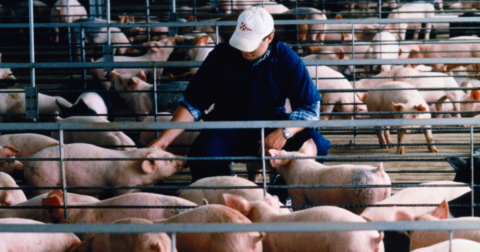Feature
Maine Was First to Ban Spreading PFAS-Contaminated Sludge on Farmland. Now Sludge Is Filling up Landfills.
Health•19 min read
Explainer
The water pollution regulations were issued five years ago. Why are they only being enforced now?


Words by Seth Millstein
In an attempt to reduce water pollution, Michigan regulators unveiled strict new rules in 2020 governing how the state’s factory farms dispose of their manure. But up until now they have never been implemented.
Now, after more than five years of litigation, the regulations are finally going into effect. It’s a win for the environmentalists who pushed for these tighter regulations — but also an illustration of the way that protracted lawsuits from interest groups can delay regulatory progress.
The tougher limits on factory farm pollution were finalized at the end of October in a decision by the director of Michigan’s environmental regulation agency, and supplant a less stringent 2015 regulation. The news came after several years of lawsuits from the Michigan Farm Bureau, an industry lobbying group.
“It is unfortunate that it took as long as it did,” Katie Garvey, senior attorney at the Environmental Law and Policy Center, tells Sentient. “I don’t think anybody thought that it would take five and a half years.” Garvey’s organization filed an amicus brief in support of the regulations during its legal battle.
The new rules were celebrated by environmentalists in Michigan and beyond who have long called for heightened scrutiny and regulations of factory farms, also known as Concentrated Animal Feeding Operations (CAFOs). But their long path to implementation highlights how difficult it can be to successfully implement new environmental protections.
Large-scale animal farms are the largest source of water pollution in the United States. The manure, pesticides, fertilizer and antibiotics from CAFOs routinely make their way into nearby waterways, which can lead to contaminated drinking water, mass fish die-offs, degraded aquatic habitats and poisoned seafood. This is a problem wherever factory farms exist, but it’s an especially big issue in Michigan, where CAFOs produce 17 million more pounds of waste every day than all of the state’s human residents.
Of particular note is the contamination of Lake Erie, one of the largest lakes in the U.S. and a top tourist attraction in the state. An excess of phosphorus in lakes regularly produces harmful algae blooms, an overgrowth of algae that can kill pets, sicken humans and destroy aquatic life. Harmful algae blooms occur when manure, some of which contains high concentrations of phosphorus, makes its way from CAFOs into waterways.
“It’s terrible for the lake itself, but it also has really bad potential human impacts,” Garvey says. “Those algae produce cyanotoxins, which can be toxic. They can kill people, they can lead to severe liver damage, kidney damage, things like that.”
Human deaths from algae blooms are very rare: the CDC reports one death in 2020 from paralytic shellfish poisoning (the shellfish was not commercially harvested). But any human or pet who swims in or drinks water contaminated with harmful algae blooms is liable to get sick — nausea, vomiting and diarrhea are common symptoms — as are those who eat seafood harvested from such water. Harmful algae blooms in freshwater such as the Great Lakes tend to produce a liver toxin that can cause liver damage, according to the National Institute of Environmental Health Sciences. Studies have shown that exposure to cyanotoxins may be linked to a higher risk of cancer and neurodegenerative disease. The health risks of harmful algae blooms are higher for those with lower body masses, namely children and pets.
It was once thought that only relatively warm and shallow bodies of water were vulnerable to algae blooms, Garvey says, but now they are common in Lake Erie and other Great Lakes. “Lake Superior is basically an ocean, and Lake Superior has harmful algal blooms, and it’s really, really dangerous,” she says.
While Lake Erie’s harmful algae blooms have received a lot of attention, Garvey notes that it’s not the only lake in the state to have them. “It’s a huge problem in the eastern part of the state near where Lake Erie is, but it’s also becoming an increasing problem in inland lakes and streams,” Garvey says.
In addition to phosphorus, manure from CAFOs can also pollute the environment with E. coli. This has become a significant issue in Michigan. The state estimates that around half of all waters in the state have more E. coli than water quality standards allow for, and in June, the state closed or restricted access to six beaches because their waters had potentially dangerous levels of E. coli.
The new rules are aimed at limiting the damage CAFOs cause to the state’s lakes and waterways, largely by addressing the ways in which farms manage their manure.
CAFOs often dispose of animal waste by spraying it onto their fields as untreated fertilizer. While this is convenient for farm operators, it often results in the manure seeping into and contaminating nearby rivers, lakes and streams. The new permitting rules place restrictions on this type of manure disposal.
Farms will no longer be allowed to apply manure as fertilizer when it’s raining, on land that is flooded or saturated or between the months of January and mid-March. CAFOs are also prohibited from transferring manure to other facilities for these purposes during the first three months of every year, and are only allowed to apply manure as fertilizer on frozen fields in specific circumstances.
There are complex scientific reasons behind these restrictions, but most of them boil down to one fact: When it’s cold outside, it’s easier for manure to pollute the water.
When manure is sprayed onto fields, there’s always a risk that rainfall will transport that manure into nearby waterways. But its propensity to do so is heavily influenced by the atmospheric and environmental conditions at the time, says Ehsan Ghane, professor of Biosystems and Agricultural Engineering at Michigan State University. Michigan’s new permitting rules are designed to take this into account, Ghane tells Sentient.
When rain falls on manure-treated soil, it becomes contaminated with the manure’s nutrients. But when the weather is warmer, more of that rain evaporates or is sucked up by the roots of plants. This process, called evapotranspiration, turns the rain to water vapor in the atmosphere, where it’s unable to carry phosphorus into lakes and streams. Even in October and November in Michigan, Ghane says, “if there’s water, it evaporates from the ground.”
But when it’s colder outside, very little evapotranspiration occurs. That’s why Michigan’s new rules prohibit the application of manure as fertilizer during the colder months of the year, Ghane says. “In January and February, evapotranspiration is so low” that if there is rainfall or melted snow, Ghane says, “it’s just going to go through the soil and out into the surface water.”
In addition to all of this, the new permitting rules require CAFOs near impaired watersheds, or waters with excess amounts of certain pollutants, to conduct enhanced monitoring of their groundwater and comply with other site-specific measures, which Garvey calls “a huge deal.”
The new regulations also crack down on a practice known as “manifesting” that CAFOs often use to evade regulation. This is when factory farm operators conduct certain elements of their business, such as manure disposal, under separate LLCs that they’ve created. Because these LLCs don’t meet the legal definition of a CAFO, they aren’t subject to the same regulations.
Garvey says that the new rules regarding manifesting “could have maybe gone farther” to crack down on the practice, but should still “go a long way to capping the kind of gamesmanship that was happening” in this way.
When the updated permitting rules were first issued in 2020, they were the target of two separate challenges by farm interest groups: A standard lawsuit, which was litigated in the courts, and an administrative appeal, which was processed through Michigan’s Office of Administrative Hearings and Rules. The administrative appeal challenged specific components of the new regulations, while the lawsuit argued more broadly that Michigan’s environmental agency didn’t have the authority to issue the new rules in the first place.
The lawsuit made its way up to the Michigan Supreme Court, and in 2024, the high court ruled that Michigan regulators did have the authority to issue the new permitting regulations. In theory, this should have cleared the way for the new permitting rules to take effect.
But there was a further delay: When the legal challenge arrived at the state Supreme Court, the administrative law judge opted to pause the administrative proceedings until the legal challenge was resolved. When the state Supreme Court ruled, the administrative office needed to resume and complete its own review of the regulation.
It did, but the process took more than a year. Ultimately, the administrative appeal ended up more or less the same way as the legal appeal, with the judge allowing the regulations to go ahead as originally written with some slight modifications.
The half-decade delay in implementing the new rules has had a real, tangible effect on the environment. During those five years, CAFOs have continued to slather phosphorus-rich manure on fields, and that phosphorus will still be in the soil, susceptible to becoming runoff, even when additional manure is no longer being applied.
“If it just stops now, there’s going to be years of phosphorus algal blooms in Lake Erie, because the soil already has the phosphorus in it,” says Ghane, who’s written about the longevity of so-called “legacy phosphorus” in soil and its long-term impacts on waterways. “It’s just slowly going to leach. It’s very, very slowly, over years, so even if no one applies [any more manure], hypothetically, it will still continue to be an issue.”
The lengthy saga of Michigan’s discharge permit is a stark reminder of how interest groups, legal challenges and bureaucracy can gum up the works and slow the progress of environmental regulators.
Nevertheless, environmentalists in Michigan are mostly cheering the long-delayed implementation of these new regulations, and for good reason: It was a hard-fought legal battle that will almost certainly reduce manure leakage into the state’s waterways, and as a result, make Michigan’s water cleaner and safer for everyone.